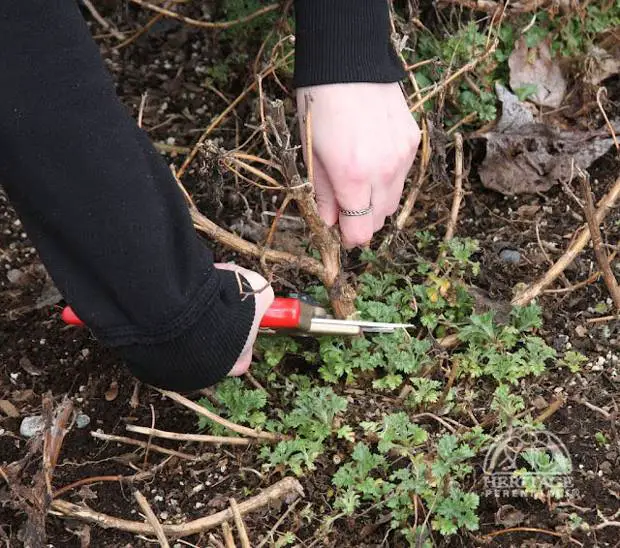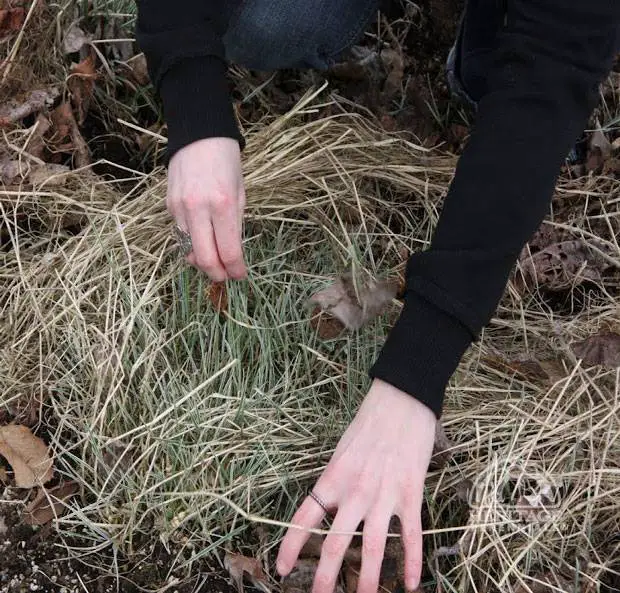Spring Cleaning in the Perennial Garden
Perennials 101, Seasonal Activities through the Year
Surely spring is the busiest season of the year for the avid perennial gardener. Fortunately, most of us have been cooped up indoors all winter and are anxious to get outside anyhow, and the cool but pleasant spring weather beckons to our gardening spirit!

Is it time yet?
The dead tops of perennials that have been left to stand through the winter are truly not fussy about when you get around to cutting them back. However, heavy and wet clay soil is not a pleasant thing to slog through, and if you have clay soil it might be better to wait until it has a chance to dry out a bit. Treading on wet clay can easily lead to soil compaction — retarding soil drainage and reducing the tiny air spaces that plants require for strong and healthy root growth. Walking within the border too early can also damage the emerging or still-hidden tops of perennials and bulbs. It’s a better idea to wait a bit until your bulbs at least begin to awaken. Some gardeners put down pieces of plywood to walk on, which helps to spread the weight and reduce compaction in any one spot. Another idea is to take advantage of the frozen soil surface first thing in the morning, a sneaky way to get across even a boggy site without causing very much damage.
Which perennials to cut back, and how?
There are basically four types of perennial growth patterns to be aware of when it comes to cutting things back in spring:
1. Evergreen perennials, including many alpines will require no cutting back or only a minimal amount of tidying up. By March or April, if the plant looks green and healthy still, then leave it alone. If just a few leaves are tattered or brown it’s simple enough to trim them back or remove them using sharp scissors or hand pruners. Spring-flowering alpines, for example: Wall Cress (Arabis), Rock Cress (Aubrieta), Basket-of-Gold (Aurinia), Pinks (Dianthus), Candytuft (Iberis), Moss Phlox (Phlox subulata) may suffer a few brown tips over the winter, but no major pruning should be done until after they finish blooming. At that time plants may be trimmed back to half their height using a pair of hedge shears, to encourage a dense and bushy habit.
2. Semi-evergreen perennials sometimes stay completely evergreen in mild winter regions but for many of us they may look so beat up by spring that some of the more tattered leaves need to be removed. Among these are: Bergenia, Coral Bells (Heuchera), Foamy Bells (Heucherella), Foam Flower (Tiarella, Japanese Sedge (Carex), and various ferns.
3. The tall, upright flower stems of Shasta Daisies (Leucanthemum), Coreopsis and Rudbeckia die back in late fall, but these plants keep low ground-hugging rosettes of evergreen leaves that become especially obvious in early spring. Remove the dead upright tops first, then see what the bottom leaves look like. These too may be trimmed a little if they look untidy, removing dead tips with scissors or shears. It’s picky work, so if you just ignore them for a bit the new spring growth will quickly freshen up their appearance.
4. Woody Perennials are better left alone until well into mid-spring before pruning them back. Generally about 6 inches of woody stem is left at the base for the new buds to appear from. Accidentally cutting them right back to the ground will sometimes cause these plants to die. Some examples of woody perennials: Artemisia ‘Huntingdon’ and ‘Powis Castle’, Butterfly Bush (Buddleia), Blue-beard (Caryopteris), Shrubby Wallflower, (Erysimum ‘Bowles’ Mauve’), Fuchsia, St. John’s-wort (Hypericum), Lavender (Lavandula), Tree Mallow (Lavatera), Russian Sage (Perovskia), Cape Fuchsia (Phygelius), Lavender Cotton (Santolina).
True herbaceous perennials are those that die completely back to the ground in winter. Fortunately, this includes the vast majority of common garden perennials. With these, it’s an easy decision — cut everything right back to ground level. A few examples: Peonies, Daylilies, Summer Phlox, Solomon’s Seal, Hosta.
Don’t wait TOO long!
Although cutting back too early can compact the soil badly, waiting until too late in the spring will leave you with a tangled mess of dead plant tops and fresh spring growth. This is very time-consuming to try and deal with, so waiting until late May for example is something to try and avoid also.
What to do with the dead junk?
Unless you suspect or recall a disease problem from the previous season, the dead tops of most perennials can be chopped into small pieces and added to your compost pile. Alternating the dead stuff in layers with green lawn clippings and other “green stuff”, along with the occasional shovel-full of garden soil will have your compost pile off to a great start.
Dispose of any dead tops from diseased plants. Also discard the seedheads of anything you want to discourage from spreading, including both weeds and flowers.
Spring weeding
Once things are cut back and the dead tops raked away, overwintered weeds become fairly obvious. Get rid of these in the spring while they’re small and well ahead of when they flower and set seed. Annual weeds (chickweed, garlic mustard) are easy to pull out while the soil is moist. Perennial weeds, particularly deep-rooted ones, may require the help of a fork or dandelion digger to get the entire root system. Discard the roots of perennial weeds in the garbage, not the compost pile.
Spring Fertilizing
Some gardeners fertilize every spring, others not quite so often. Newly planted borders are usually good for a couple of years if the soil was prepared well initially. Older gardens often are re-invigorated by a spring feeding, and if you use a mulch of wood chips or bark it is a wise idea to fertilize your perennials every spring. When mulch begins to rot the bacteria responsible will rob the soil of available nitrogen.
There are boxes of fancy perennial food readily available in garden centers, and these are fine if your garden is relatively small. For larger borders it’s a much better deal to buy large bags of all-purpose vegetable garden fertilizer. Look for something with a high middle number (e.g. 5-10-5, 10-15-10) to promote strong stems and lots of flowers. Do NOT be tempted to use lawn fertilizer on your perennials — it is too high in the first number, nitrogen. Also, don’t ever use a “weed and feed” formulation on any part of your garden other than lawn grass.
Whatever product you choose, follow the manufacturer’s rate carefully. Sprinkle fertilizer AROUND your perennials, not directly on top of the clumps. This will help to avoid burning the foliage.
To Mulch, or not to mulch…
The benefits of an organic mulch are many. They add humus-forming organic matter to the soil, improving its structure and eventually supplying food to your perennials. They cover the soil and smother many seeds, reducing the amount of weeding required. The biggest benefit with mulching is that it helps to keep the soil cool and moist during the summer months, thereby reducing watering needs and avoiding drought stress. Mulch should be no thicker than 2—3 inches and should taper off to nothing as it approaches your perennial clumps. In other words, don’t heap mulch all over and smother your plants to death.
Choose a mulch that is good value. This varies from region to region, and includes such things as shredded bark, cocoa beans, rice hulls, commercially bagged or municipal compost, composted steer manure, pine needles and many, many other products. Plain sphagnum peat moss is not a good mulch because it has a tendency to repel water and can blow all over the place.
If you have terrible problems with slugs, consider removing all of your old mulch this spring, leaving the soil exposed to the sun for a few weeks, then replacing with fresh mulch. This will help to eliminate overwintered slugs, snails and their eggs.
Edge your beds
If you didn’t get around to it last fall, spring is a good time to freshen up those bed edges. When you do this, try to follow any invading grass roots and remove them entirely before they invade nearby clumps of perennials.
Moving or dividing perennials in the spring
Spring is an ideal time to move or divide the vast majority of perennials, particularly if you live in a very cold region (Zones 1 to 4). Even the early spring-bloomers can be moved, so long as it gets done before they flower. This might sacrifice a few blooms for the current season, but next year’s display will be especially grand.
Gardeners often ask us when the best season is to move specific perennials, so we have a working “rule of thumb” for timing.
John’s Rule-of-Thumb for when to move or divide perennials
If the plant blooms between early spring and late June, then early fall division/moving is ideal. That being said, you can nearly always get away with doing this in spring, if necessary.
If the plant blooms after late June, then early spring division is ideal.
Exceptions to the rule are: Peonies (move/divide in fall only), Oriental Poppies (move/divide in August), Bearded Iris (move/divide in July through September ideally, or spring as a second choice) and true Lilies (move/divide in mid to late fall).
Of course, you can always break the rules and see what happens. Just remember that if you move or divide a perennial later in the season when it’s big and bushy bushy always cut back the foliage by at least half to prevent serious wilting. This helps to keep the leaf mass in proportion to the reduced number of roots!
A few other tips: fall-blooming ornamental grasses that were left for winter interest need to be cut back before any new growth appears from the base. Some of these, particularly Miscanthus selections, aren’t even going to think about growing until late spring. Gardeners sometimes take advantage of this and leave a few clumps to stand as a lovely contrast to spring-flowering bulbs.
The old leaves of Lenten Roses (Helleborus orientalis or Helleborus hybridus) should be cut right back to the ground in late winter. This allows the emerging new flowers to be seen at their best. Do not trim back most other Hellebores, including Christmas Rose (Helleborus niger).
The old leaves and stems of Barrenwort (Epimedium) should also be trimmed to the ground in late winter.
Hellebores and many other woodland plants may have dropped seed last season that will germinate during the cold days of early spring. Try to be gentle when raking around these, to avoid disturbing any tiny seedlings that might be starting to push through the ground. If you do notice seedlings, wait until early fall to move them to a new location, or even the following spring.
Bearded Iris of all types tend to carry some green leaves through the winter. Carefully pull off any dead leaves in spring and dispose of them, since they can harbour the dreaded Iris borer. If any clumps failed to flower the previous season, you might as well divide them in spring rather than waiting until the traditional summer-dividing time.
